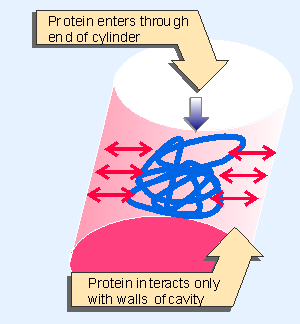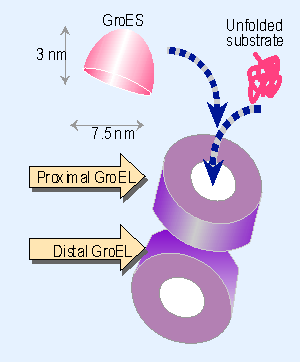4. Hsp60GroEL forms an oligomeric ring structure
8.4 Hsp60/GroEL forms an oligomeric ring structure |
 |
Figure 8.7 A protein may be sequestered within a controlled environment for folding or degradation. Animated figure |
Large (oligomeric) structures with hollow cavities are often used for handling the folding or degradation of proteins (for review see Horwich et al., 1999). The typical structure is a ring of many subunits, forming a doughnut or cylinder. Figure 8.7 shows that the target protein is in effect placed in a controlled environment Xthe cavity Xwhere it is closely associated with the surrounding protein. This creates a high local concentration of binding sites and supports cooperative interactions. In the case of folding, the closed environment prevents the target protein from forming wrongful interactions with other proteins, which may be important in driving folding along the proper pathway. In the case of degradation, isolation presumably makes for a more controlled process than would be possible in open cytosol (see 8.16 Protein degradation by proteasomes). The energy for these processes is provided by hydrolysis of ATP Xtypically the subunits of the ring are ATPases.
 |
Figure 8.8 GroEL forms an oligomer of two rings, each comprising a hollow cylinder made of 7 subunits. |
The Hsp60 class of chaperones forms a large apparatus that consists of two types of subunit. Figure 8.8 illustrates the structure schematically. Hsp60 itself (known as GroEL in E. coli) forms a structure consisting of 14 subunits that are arranged in two heptameric rings stacked on top of each other in inverted orientation. This means that the top and bottom surfaces of the double ring are the same. The central hole is blocked at the equator of each ring by the COOH ends of the subunits, which prrotrude into the interior. So the ends of the double cylinder form symmetrical cavities extending about half way into each unit.
 |
Figure 8.9 Two rings of GroEL associate back to back to form a hollow cylinder. GroES forms a dome that covers the central cavity on one side. Protein substrates bind to the cavity in the distal ring. |
This structure associates with a heptamer formed of subunits of Hsp10 (GroES in E. coli). A single GroES heptamer forms a dome that associates with one surface of the double ring, as shown in Figure 8.9. The dome sits over the central cavity, thus capping one opening of the cylinder. The dome is hollow and in effect extends the cavity into the closed surface. We can distinguish the two rings of GroEL as the proximal ring (bound to GroES) or the distal ring (not bound to GroES). The entire GroEL/GroES structure has a mass ~106 daltons, comparable to a small ribosomal subunit. GroEL is sometimes called a chaperonin, and GroES is called a co-chaperonin, because GroEL plays the essential role in guiding folding, but GroES is required for its activity (Braig et al., 1994; Hunt et al., 1996; Xu et al., 1997).
GroEL binds to many unfolded proteins, probably by recognizing a condensed "molten globule" state. Interaction with the substrate is based on hydrophobic interactions between surfaces of the substrate and residues of GroEL that are exposed in its central cavity. Substrates may be provided by proteins that have become denatured; or they may be transferred to GroEL by other chaperones Xfor example, Hsp70 may assist a nascent protein in folding, but then passes it on to GroEL for the process to be completed when it is released from the ribosome.
 |
Figure 8.10 Protein folding occurs in the proximal GroEL ring and requires ATP. Release of substrate and GroES requires ATP hydrolysis in the distal ring. Animated figure |
The key reactions in substrate binding and folding are illustrated in Figure 8.10. The reaction starts when substrate and ATP are bound to the same ring of GroEL. This defines the proximal ring. Then GroES caps this ring. Binding of GroES induces a conformational change in the proximal GroEL ring, increasing the volume of the central cavity. This also changes the environment for the substrate. The hydrophobic residues in GroEL that had previously bound substrate are involved in binding to GroES. The result is that the substrate now finds itself in a hydrophilic environment that forces a change in its conformation (Chen et al., 1994; Mayhew et al., 1996).
ATP plays an important role in GroEL function. Each subunit of GroEL has a molecule of ATP. The presence of ATP on the subunits of the proximal ring is required for folding to occur. Hydrolysis is required for the transition to the next stage. Hydrolysis of the ATP in the proximal ring changes the properties of the distal ring in such a way as to allow substrate and ATP to bind to it. This in turn triggers the dissociation of the substrate and GroES from the proximal ring. Now the situation at the start of the cycle has been restored. The ring that was the distal ring in the previous cycle is bound to substrate and ATP, and becomes the proximal ring for the next cycle. So the rings of GroEL alternate as proximal and distal (Rye et al., 1997; Rye et al., 1999).
An important question in the action of this (and other macromolecular) chaperones is whether their action is processive. Does a substrate enter the central cavity, undergo multiple cycles of folding within it, and become released in mature form? Or does it undergo a single folding cycle, after which it is released; typically it will still have improperly folded regions, and therefore will be bound again for another folding cycle. This process will continue until the protein has reached a mature conformation that does not offer a substrate to the chaperone.
These models have been tested by using a mutant GroEL that can bind unfolded proteins but cannot release them. When this "trap GroEL" is added to wild-type GroEL that is actively engaged with a substrate, it blocks the appearance of mature protein. This suggests that the substrate has been released before folding was completed. The simplest explanation is that substrate protein is released after each folding cycle. One cycle of folding, ATP hydrolysis, and release takes about 15 sec in vitro (Weissman et al., 1994; Weissman et al., 1995).
This section updated 5-3-2000
| Reviews | |
| Horwich A.L., Weber-Ban E.U., Finley D. (1999). Chaperone rings in protein folding and degradation.. Proc. Nat. Acad. Sci. USA 96, 11033-11040. | |
| Research | |
| Braig, K. et al. (1994). The crystal structure of the bacterial chaperonin GroEL at 28 Å. Nature 371, 578-586. | |
| Chen, S. et al. (1994). Location of a folding protein and shape changes in GroEL-GroES complexes imaged by cryo-electron microscopy. Nature 371, 261-264. | |
| Hunt, J. F. et al. (1996). The crystal structure of the GroES co-chaperonin at 28 Å resolution. Nature 379, 37-45. | |
| Mayhew, M. et al. (1996). Protein folding in the central cavity of the GroEL-GroES chaperonin complex. Nature 379, 420-426. | |
| Rye H.S., Roseman A.M., Chen S., Furtak K, Fenton W.A, Saibil .H.R., and Horwich. AL. (1999). GroEL-GroES cycling: ATP and nonnative polypeptide direct alternation of folding-active rings.. Cell 97, 325-338. | |
| Rye, H. S. et al. (1997). Distinct actions of cis and trans ATP within the double ring of the chaperonin GroEL. Nature 388, 792-798. | |
| Weissman, J. S. et al. (1994). GroEL-mediated protein folding proceeds by multiple rounds of binding and release of nonnative forms. Cell 78, 693-702. | |
| Weissman, J. A. et al. (1995). Mechanism of GroEL action: productive release of polypeptide from a sequestered position under GroES. Cell 83, 577-587. | |
| Xu, Z., Horwich, A. L., and Sigler, P. B. (1997). The crystal structure of the asymmetric GroEL-GroES-(ADP)7 chaperonin complex. Nature 388, 741-750. | |